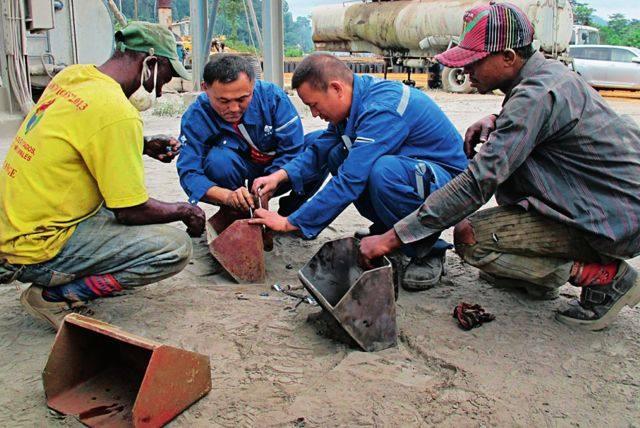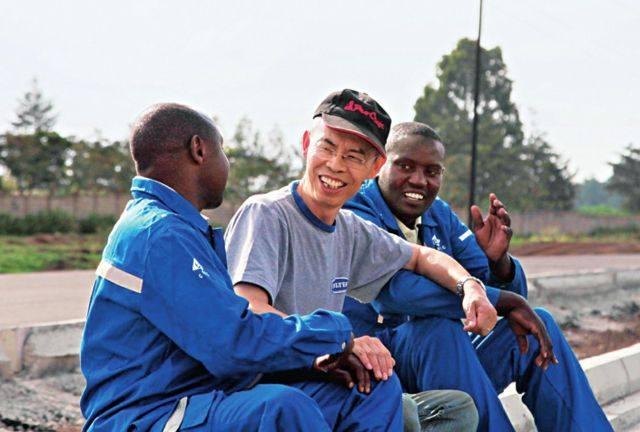CRBC: Africa Constructor
By staff reporter HOU RUILI
ALL types of heavy-duty vehicles bound for different inland countries travel Highway A109 that connects Mombasa, East Africas largest harbor, and Nairobi, capital of Kenya. The superlative quality of this project has guaranteed a transport capacity far surpassing that of the original design level. The landscape constructions on either side of the road are also engineering works of art. The Kenyan government has issued a stamp highlighting this superb highway, known as the China Road, and the friendship between China and Kenya.
In response to Chinas policy since the 1960s of aid to Africa, the China Road and Bridge Corporation (CRBC) has been committed to building infrastructure there, such as roads, bridges, tunnels, ports, and wharves. At present, CRBC has offices in 25 African countries where 98 projects are in progress. In addition to improving local residents lives, some, such as the China Road in Kenya and the Friendship Harbor in Mauritania – hailed as symbols of national independence and models of South-South cooperation – have exerted far-reaching influence on the continents social and economic development.
Leading Engineering Technology
On May 11, 2014, Chinese Premier Li Keqiang and Kenyan President Uhuru Kenyatta attended the signing ceremony of the China-Kenya co-financing agreement on the Mombasa-Nairobi Railway Project, involving US $3.804 billion. This, Kenyas longest ever railway, began construction in October 2014, and will be built entirely according to Chinese standards, according to CRBC president Wen Gang. When completed, it will cut the travel time between the two cities from more than 10 hours to four hours.
Among highway constructions in Africa, Chinese-built roads stand out by virtue of their high quality and safe design and construction. In the 1970s China built the first-stage Bata-Niefang Road in Equatorial Guinea as an aid project. Owing to constrained construction conditions at that time, however, the standard of building was not high, particularly in view of the roads many sharp turns and long, steep slopes. The countrys rapid economic growth in recent years brought with it a surge in transport demands, and hence the urgent need to modify and optimize this road. CRBC presented to the government of Equatorial Guinea an optimal design plan, and contracted to reconstruct and extend the road. CRBC spent one year and eight months widening it from seven meters to 11 meters and ameliorating its 20 dangerous bends. The project was completed in August 2013.
“In all my years as a truck driver I think the stretch of renovated road from Bata to Niefang is the best there is. It has shortened the journey, and there are fewer sharp turns. Before I would often see traffic accidents along this road but now I have no worries about making round trips along it,” said 52-year-old driver Constantino Okua.
China has constantly focused on infrastructure construction since enacting its reform and opening-up policy of 1978. Thanks to practices in domestic construction, the country has made steady technological improvements and innovations to infrastructure.
“In the field of bridge technology, such as the newest suspension and cable-stayed bridges, those of the best quality are almost all in China. And Chinese high-grade highways are of a standard similar to those in the U.S.,”Wen Gang said. “Various practices have cultivated a large amount of talent. At present, China leads the world in infrastructure construction, including airports, harbors, highways, and railways. Moreover, among the wave of Chinese enterprises going global, infrastructure companies are the most successful. They have played an important role in Chinas economic development and bilateral trade and economic contacts, as well as promoting diplomatic relations.”
Diligent Chinese Workers
As regards infrastructure construction, Western countries often prefer to invest rather than contract. With the support of hard-working engineering technicians, however, China can both maintain and develop its overseas contracted projects.
Owing to the demands of his job, electrical engineer Ren Yushan was transferred to Equatorial Guinea in 2001, at his prime working age, to take charge of mixing bituminous concrete on the Bata-Niefang Road renovation and extension project. Ren, from northwest China, goes to great lengths to eradicate all problems, no matter how minor, in his work. When, on one occasion, a mixing plant was not operating properly he immediately set about carrying out repairs. As the machinery roared, Ren shouted instructions to local workers on mechanical operations and the need for maintenance. He also used body language to drive home these points and ensure they understood. When he first arrived in Africa, the low-end mixing plant had a limited yield. To fulfill engineering needs, Ren would start work at 3 a.m. During the first three months he averaged less than four hours of sleep a night.
Construction work in Africa entails extensive site clearing. Exposure to clouds of mosquitos makes those carrying out such work prey to malaria and filariasis. Although the construction site clinic is constantly expanding it is always crowded with patients. Engineering construction can consequently only be carried out during the dry season, and construction workers must do extras shifts to complete works in progress. Fainting fits as a result of high temperatures and sunburn are common among workers on site.
Local Benefits
John Wangai Gichungu is one of the 1,472 indigenous workers on the CRBC construction site on Nairobis South Ring Road. He drives a heavy-duty trailer conveying building materials. About 10 percent of such laborers have worked for CRBC for more than a decade. Some have moved with the company to complete a number of engineering projects. Around 95 percent of Johns fellows are locals. During the construction period, local undergraduates often visit the site looking for internships, some of whom will join CRBC after graduation. Local workers account for around 80 percent of CRBC employees in Africa, according to Wen Gang.
Before he started working for CRBC in 2000, John rented a small room in a village far from the capital. He has since married and had four children. He and his family now live in a fine, large house.
The 52-km-long Northeast Ring Road that connects to the South Ring Road has been open to traffic since 2012. It has considerably eased Nairobis traffic congestion, having slashed to 30 minutes the former three-hour drive from the airport to the so-called Thika Superhighway. Deliah Wendy Aminilwa daily commutes on this road, and so no longer needs to get up at 4 a.m. She now has time to enjoy a good breakfast before setting out on her 20-minute journey to work.
Schools, hospitals, and shopping centers have also mushroomed along the Northeast Ring Road, and land prices have risen five-fold. “A highway of this caliber both changes our traffic and keeps the spirits of local residents buoyant. Our country has changed a lot,” said a member of parliament. “We believe that the Chinese people are our sincere friends. Kenya has decided to establish a closer cooperation with China and follow Chinas development mode.” After completion, the Mombasa-Nairobi Railway will increase Kenyas GDP by 1.5 percent annually.
Chinas infrastructure construction expands local employment opportunities and increases tax revenues, and enables local governments to achieve their development goals, according to Wen Gang, contributing greatly to promoting local economy and improving peoples livelihood.
Jesus Nvondong, personnel representative of the Bata-Niefang Road extension project, is a China hand who has been working with CRBC teams for six years. “I trust Chinese people. They are honest, trustworthy and respect us, which is why I stay at CRBC,” Nvondong said.
Allan Agunda, a 33-year-old Kenyan, has worked for CRBC for 14 years. His stable job and handsome pay have enabled him to adopt an orphaned boy.“In the past, I never dreamed I would be able to leave poverty behind and help poor people nearby, but now I can. Like my two other children, my adopted son enjoys equal educational opportunities and a happy life. He admires my job, and both of us believe that we can make a difference through efforts. It is the Chinese people who have given us these opportunities and strength. I, my wife and our children will always be thankful,” Allan said.
There are many cities and villages along the Bata-Niefang Road, and CRBC also digs wells for communities lacking access to water. For example, women in Midjimiton Village formerly had to walk two kilometers to fetch water from a river. When it ran dry they had to walk even farther. Since CRBC dug the villages first well, local people have had ready access to potable water. Children regard the well as a treasure. “Our country is in the process of construction. CRBC not only built the high-grade road that runs through our village, but also paved access roads and dug a well, so bringing us tangible benefits. For us, CRBC workers are like relatives and brothers,” Midjimiton Village head Candido Ekong said.
CRBC has also built schools and churches along the road, and a clinic that is under construction will improve local health standards.
Besides projects and public facilities, CRBC, as a local corporate citizen, is also involved in direct investment. “By purchasing land for long-term business dealings, CRBC has become a mentor of local construction and so served local residents,” Wen Gang said. CRBC has invested in many local projects, including a cement plant, real estate, an industrial park, a new town, and a harbor. These projects are not merely to gain economic benefits, but also to generate social benefits by helping local people gain confidence in Chinas projects and the integrity of Chinese people, Wen said.
Most important, CRBC has always performed its duty as a constructor by maximally protecting local natural environment through ideal design.“Understanding of and capacity for environmental protection are important indicators of an enterprises strength,”Wen Gang said. “We are constructors, not destroyers. We strive to minimize environmental disruption.” As the Mombasa-Nairobi Railway will run through several national parks, CRBC has built special wildlife passages, some of which allow giraffes to pass through. This means elevated railroad beds, and hence higher construction costs due to fetching earth from outside these parks. CRBC has also built slopes to protect water sources.
Nowadays, more than 60 percent of CRBCs business is in Africa. The company strives to make contributions to Africa out of a sense of responsibility.

